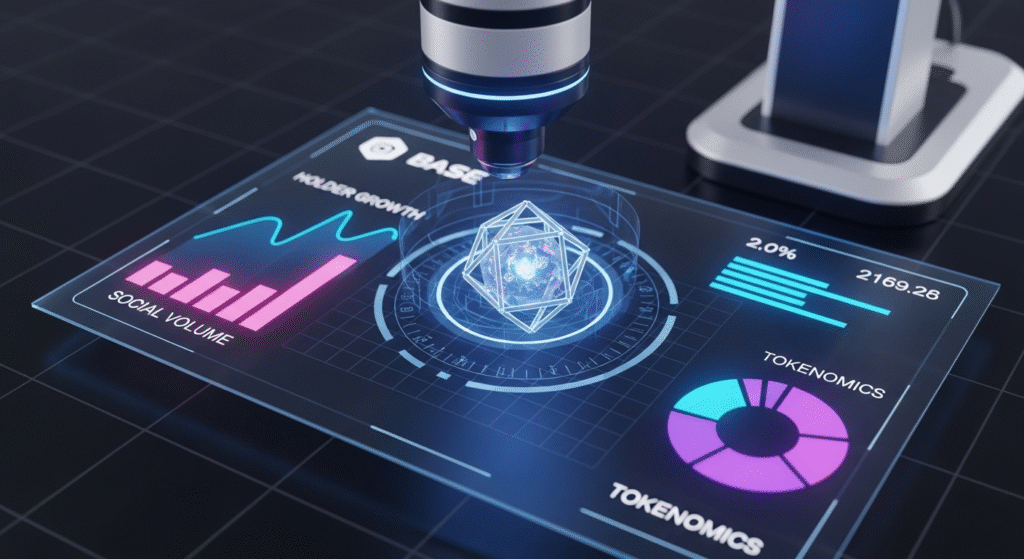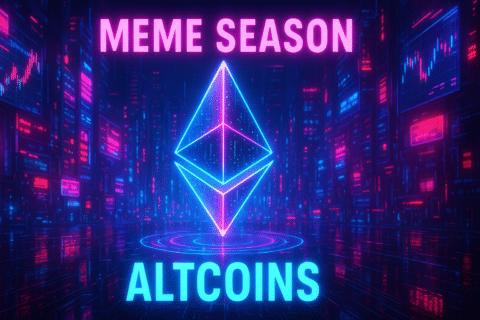.
Was Your Last Crypto Investment a Wild Guess? 7 Secrets to Finding Top Altcoins
The cryptocurrency market is a pulsating ecosystem, constantly evolving with new innovations and opportunities. But for many, navigating this landscape, especially when it comes to finding promising altcoins, can feel like searching for a needle in a digital haystack. How many times have you scrolled through endless projects, hoping to strike gold, only to be met with disappointment? The truth is, while luck plays a role, a strategic, data-driven approach can significantly boost your chances of discovering hidden gems. And today, we’re diving deep into a niche that’s captured the crypto world’s attention: Base Memes.
The rise of meme coins, particularly those launching on newer, more accessible blockchains like Base, has been nothing short of extraordinary. These aren’t just jokes on the blockchain; they represent a fascinating intersection of internet culture, community building, and sometimes, surprisingly robust technological underpinnings. But with this surge in popularity comes a wave of new projects, making it harder than ever to discern the genuine opportunities from the fleeting fads.
In this comprehensive guide, we’ll equip you with seven data-backed secrets to help you pinpoint top altcoins, with a special focus on the burgeoning world of Base meme coins. Whether you’re a seasoned crypto veteran or a curious newcomer, these insights will empower you to make more informed investment decisions, understand the underlying mechanics, and navigate the exciting, albeit sometimes volatile, altcoin market. Let’s uncover the strategies that can turn your crypto research from a gamble into a calculated pursuit of value.
Crypto Market Overview: The Shifting Sands of Altcoins and Memes
The cryptocurrency market is a dynamic environment, and the altcoin sector is its most vibrant and volatile frontier. While Bitcoin and Ethereum often dominate headlines, a constant stream of new tokens emerges, each vying for attention and investor capital. Currently, we’re witnessing a pronounced trend towards innovation on Layer 2 solutions, particularly those built on Ethereum. Base, developed by Coinbase, has rapidly become a breeding ground for new projects, including a significant influx of meme coins.
Data from various on-chain analytics platforms reveal a surge in trading volume and new token creation on Base. For instance, Dune Analytics dashboards regularly showcase spikes in daily active users and transaction counts on the network, often driven by the popularity of these meme coins. This influx is not just about speculative trading; it signifies growing developer interest and user adoption for these newer ecosystems.
Furthermore, the broader altcoin market is showing signs of maturation. Institutional interest in cryptocurrencies beyond Bitcoin is increasing, and regulatory frameworks are slowly taking shape. This creates a more stable, though still inherently risky, environment for altcoins with solid fundamentals and community backing. Airdrops, too, remain a significant catalyst for user acquisition and network growth, often rewarding early adopters and participants in new ecosystems, including those on Base. Understanding these overarching trends is crucial when you’re trying to identify which Base Memes and other altcoins have the potential for long-term success.
The Core Concept: How Base Memes and Altcoins Actually Work
To effectively navigate the altcoin market, particularly the burgeoning world of Base Memes, it’s essential to understand the foundational concepts. This isn’t just about following hype; it’s about grasping the underlying technology, purpose, and community dynamics that drive these digital assets.

What Are Altcoins / Meme Coins / Airdrops?
Let’s break down these terms:
Altcoins: The simplest definition of an altcoin is any cryptocurrency that is not Bitcoin. This category encompasses thousands of digital assets, each with its unique purpose, technology, and market. Altcoins can range from established projects like Ethereum (ETH), which powers smart contracts and decentralized applications (dApps), to newer, highly specialized tokens focused on areas like decentralized finance (DeFi), non-fungible tokens (NFTs), gaming, or specific industry solutions. Their diversity is what makes the altcoin market so compelling and challenging to navigate simultaneously.
Meme Coins: Meme coins are a specific sub-category of altcoins that gain popularity primarily through social media trends, internet memes, and viral marketing campaigns. Unlike many altcoins that aim to solve specific problems or introduce new technologies, meme coins often derive their value and community from their cultural relevance and entertainment factor. Examples like Dogecoin (DOGE) and Shiba Inu (SHIB) paved the way, demonstrating that a strong community and viral appeal can drive significant market capitalization, even without substantial underlying utility in their early stages. The recent explosion of Base meme coins exemplifies this phenomenon on a new blockchain.
Airdrops: An airdrop is a distribution of cryptocurrency tokens, usually to a large number of wallet addresses, typically for free. Projects often conduct airdrops to raise awareness about their new coin, attract new users to their platform, and decentralize the ownership of their tokens. To qualify for an airdrop, users might need to hold a specific existing cryptocurrency, use a particular dApp, or perform simple social media tasks. Airdrops can be a valuable way for users to acquire new tokens and for projects to bootstrap their communities, often serving as an early indicator of a project’s growth strategy.
Key Components & Technologies
The innovation behind altcoins, including those found on Base, often hinges on potent technological advancements:
Blockchain Technology: At its core, every altcoin operates on a blockchain. This distributed, immutable ledger system ensures transparency, security, and decentralization. The specific blockchain on which a token is built dictates its transaction speeds, scalability, security features, and the types of dApps it can support. Base, being an Ethereum Layer 2 solution, inherits much of Ethereum’s security and leverages roll-up technology for faster, cheaper transactions, making it an attractive platform for new meme coins and other applications.
Smart Contracts: Many altcoins, particularly those on platforms like Ethereum, are built using smart contracts. These are self-executing contracts with the terms of the agreement directly written into code. They automatically execute actions when predetermined conditions are met, enabling a vast range of functionalities from token issuance and decentralized exchanges (DEXs) to complex DeFi protocols and gaming mechanics. The ERC-20 token standard, for example, is a widely adopted smart contract function that defines how tokens are created, transferred, and managed on the Ethereum blockchain and compatible networks like Base.
Decentralized Finance (DeFi): DeFi refers to financial applications built on blockchain technology. Many altcoins are intrinsically linked to DeFi, powering various services like lending, borrowing, decentralized exchanges, yield farming, and staking. Understanding a project’s role within the DeFi ecosystem – whether it’s providing liquidity, facilitating trading, or offering innovative financial tools – can be a key indicator of its potential. The growth of DeFi protocols on newer chains like Base continues to provide fertile ground for novel Base meme coins to integrate or leverage these financial tools.
Community and Governance (DAO): Decentralized Autonomous Organizations (DAOs) are increasingly common in the altcoin space. DAOs allow token holders to vote on proposals and decisions related to the project’s development, treasury management, and future direction. A strong, engaged community is often a driving force behind the success of meme coins, providing the viral marketing and support needed to gain traction. For Base Memes, community sentiment and active participation in governance can be early signs of robustness.
The Data-Driven Perspective: Unveiling Tokenomics and Trends
While the allure of quick gains is undeniable, a data-driven approach is your most potent weapon against the inherent volatility of the altcoin, and especially meme coin, market. Understanding market data, tokenomics, and analyzing trends can transform your research from guesswork into informed decision-making.
Market Data & Trends
The landscape of altcoins, particularly on emerging platforms like Base, is awash with data that can inform your investment thesis:
Trading Volume and Liquidity: One of the primary indicators of a project’s health and investor interest is its trading volume and the liquidity available on decentralized exchanges. High trading volume suggests active trading and demand, while deep liquidity means larger trades can occur without significantly impacting the price, indicating a more stable market for the token. Tools like CoinMarketCap, CoinGecko, and on-chain analytics platforms like DexScreener or DEXTools are invaluable for tracking these metrics for Base Memes. A consistent upward trend in volume and liquidity, especially relative to other tokens on the same network, is a positive sign.
Developer Activity and GitHub Repositories: For altcoins aiming for technological innovation, tracking developer activity is crucial. This includes the frequency of commits to their code repositories (e.g., on GitHub), the number of active developers, and the transparency of their development roadmap. While meme coins are often less about complex development, even they benefit from active community-driven development, such as creating new utilities or improving infrastructure. A project that is actively being built and updated signals long-term commitment.
Social Media Sentiment and Community Engagement: For meme coins, social media sentiment is paramount. Platforms like Twitter (X), Telegram, and Discord are where these communities thrive. Monitoring the volume and sentiment of discussions, the growth of followers, and the engagement levels (likes, retweets, comments) can provide insights into the project’s popularity and grassroots support. However, it’s imperative to distinguish genuine enthusiasm from bot-driven hype. Advanced sentiment analysis tools and simply observing the quality of discussions can help here.
On-Chain Activity: Analyzing on-chain data can reveal genuine usage and holding patterns beyond speculative trading. Metrics like the number of unique wallet addresses holding the token, the frequency of transactions, and the distribution of holdings can indicate a healthy, decentralized ownership structure and active participation. For Base meme coins, observing how many wallets are actively interacting with related dApps or holding the token long-term can be a strong indicator.
Tokenomics & Market Health
Tokenomics refers to the economic design of a cryptocurrency, encompassing its supply, distribution, and utility. Sound tokenomics are crucial for a token’s long-term value proposition.
Total Supply vs. Circulating Supply: Understanding the total supply (maximum number of tokens that will ever exist) and circulating supply (tokens currently available for trading) is fundamental. A low circulating supply relative to demand can drive up prices, but a fixed or rapidly decreasing supply (through burn mechanisms) can be more sustainable. For meme coins with potentially inflationary models, understanding the issuance schedule is critical.
Token Distribution and Vesting Schedules: How tokens are distributed among founders, early investors, the community, and for marketing purposes is a key indicator of fairness and decentralization. A large allocation to the founding team with no vesting schedule can be a red flag, as it increases the risk of a “rug pull” (where developers abandon the project after taking investor funds). Look for projects with a fair distribution and clear vesting periods for team tokens, ensuring they are incentivized for the long term.
Utility and Use Cases: While meme coins are known for their cultural appeal, the most resilient ones eventually develop some form of utility. This could be anything from in-game use, access to exclusive communities, staking rewards, or integration with DeFi protocols. For Base Memes, identifying any nascent utility or a clear roadmap for developing it can differentiate them from purely speculative assets. A token that is simply bought and sold without any underlying function has a much higher risk of losing all value.
Inflationary vs. Deflationary Mechanisms: Some tokens have mechanisms to reduce their supply over time (deflationary, e.g., token burns), which can theoretically increase scarcity and value. Others may have inflationary models, where new tokens are continuously minted, potentially diluting the value of existing holdings. Understanding these mechanisms is vital for predicting future price action.
Risks, Challenges & Competition
While the potential rewards in the altcoin market can be substantial, the risks are equally significant. Navigating these challenges requires a clear-eyed view of what can go wrong, and how different projects stack up against each other.
Risks of Altcoins and Meme Coins
The decentralized nature of cryptocurrencies, while a strength, also presents unique risks:
Extreme Volatility: Altcoins, and especially meme coins, are notorious for their price volatility. They can experience massive price swings in short periods, driven by social media sentiment, whale activity (large holders), or news events. This means that while you could see substantial gains, you could also lose your entire investment very quickly. This is a fundamental risk for any investment in Base Memes.
Security Vulnerabilities: Smart contracts, while powerful, can contain bugs or vulnerabilities that malicious actors can exploit. Exploits can lead to the theft of tokens or significant disruptions to a project’s ecosystem. When researching new altcoins, especially those on newer chains, thorough due diligence on the smart contract’s audit reports and the development team’s security practices is crucial.
Regulatory Uncertainty: The regulatory landscape for cryptocurrencies is still evolving globally. Governments are grappling with how to classify, tax, and regulate digital assets. New regulations could impact the legality, trading, or usability of certain altcoins, leading to price drops or project shutdowns.
“Rug Pulls” and Scams: The relative anonymity and ease of creating tokens in the cryptocurrency space make it a fertile ground for scams. “Rug pulls” are a common type of scam where developers amass funds from investors and then abandon the project, disappearing with the capital. This is particularly prevalent in the meme coin space, where hype can overshadow fundamental checks.
Lack of Utility and Sustainability: Many altcoins, especially meme coins, are created with minimal utility. Their value is purely driven by speculation and community hype. Without a sustainable use case, tokenomics designed for long-term value, or an active development team, these projects are prone to collapse once the hype dies down.
How Does Base Memes Stack Up Against Competitors?
When we talk about Base Memes, their primary competition comes from meme coins on other blockchains and utility-focused altcoins. Here’s a comparative look:
| Feature | Base Meme Coins | Meme Coins on Ethereum Mainnet (e.g., SHIB, DOGE) | Utility Altcoins (e.g., SOL, ADA, MATIC) |
|---|---|---|---|
| Blockchain Technology | Leverages Ethereum’s security via Layer 2 technology (rollups). | Directly on Ethereum Mainnet (higher gas fees, slower transactions). | Diverse range of high-performance blockchains, some L2s. |
| Transaction Costs | Significantly lower gas fees compared to Ethereum Mainnet. | High gas fees, can be prohibitive for small transactions. | Generally lower than Ethereum Mainnet, but can vary by network. |
| Speed | Faster transaction speeds than Ethereum Mainnet. | Slower transaction speeds due to network congestion. | Varies, but often optimized for speed (e.g., Solana). |
| Ecosystem Growth | Rapidly growing ecosystem driven by Coinbase integration and new projects. | Mature, well-established ecosystem with vast DeFi/NFT presence. | Mature ecosystems with extensive dApps, DeFi, and NFT marketplaces. |
| Community & Hype | Driven by strong internet culture and Coinbase’s influence. | Established, large, and highly engaged communities. | Communities often focused on technology adoption and ecosystem development. |
| Risk Profile | High (newness, potential for volatility, reliance on hype). | High (volatility, meme culture risk), but with proven track records. | Moderate to High (market volatility, technological risk), but often with utility. |
| Development Focus | Primarily meme-driven, with growing potential for utility integration. | Meme-driven, with some projects developing utility over time. | Heavily focused on developing and scaling technological solutions and dApps. |
| Potential Advantage | Lower entry barrier, potential for explosive growth on a new chain. | Strong brand recognition, vast liquidity, and established infrastructure. | Long-term utility, scalability, and sustainability. |
| Core Risk | Unproven longevity, dependence on Base network adoption. | Reliance on meme psychology, potential dilution. | Technological challenges, competition, adoption hurdles. |
This table highlights that while Base Memes offer an exciting, lower-cost entry point into the meme coin phenomenon, they operate within a newer ecosystem. Their success will depend on the continued growth and adoption of the Base network itself, alongside their ability to foster strong communities and potentially integrate real-world utility to distinguish themselves from the transient nature of pure hype.
The Future Outlook: What’s Next for Altcoins and Meme Coins?
The trajectory of altcoins, including the burgeoning sector of Base meme coins, points towards continued innovation and integration, albeit with an ever-present awareness of risk.
What’s Next for Altcoins / Meme Coins / Airdrops?
Several trends suggest where this space is headed:
- Layer 2 Dominance: The migration of activity and new project launches to Layer 2 solutions like Base is likely to continue. These networks offer scalability, lower fees, and faster transaction times, making them ideal for high-frequency transactions and new token deployments. Expect more innovation on these platforms.
- Increased Utility for Meme Coins: While the speculative aspect will persist, successful meme coins will likely need to develop tangible utility. This could involve integrating with gaming, providing access to exclusive content, building decentralized social platforms, or even facilitating micro-transactions. The focus might shift from “just a meme” to “a meme with a purpose.”
- Greater Institutional Adoption: As regulatory clarity improves, larger financial institutions may become more involved with a wider range of altcoins, not just the established players. This could bring more capital and legitimacy to promising projects.
- Sophisticated Airdrop Strategies: Airdrops will likely evolve beyond simple token giveaways. Projects might use them to incentivize specific user behaviors, reward participation in governance, or bootstrap ecosystems for new dApps, making them a more strategic tool for growth.
- Focus on Community Governance: The rise of DAOs will continue to empower token holders, giving them a direct say in project development. Projects with strong community governance models are likely to foster greater trust and long-term commitment from their user base. Understanding the governance structure of any project, including Base Memes, can offer insights into its future direction and stability.
The key takeaway is that while the excitement surrounding new tokens and viral trends is a powerful force, long-term success in the altcoin market will increasingly depend on underlying value, utility, robust tokenomics, and strong, engaged communities.
Conclusion
Navigating the dynamic world of cryptocurrencies, particularly the burgeoning realm of altcoins and meme coins, requires more than just a hunch. By understanding the core technologies, analyzing data-driven insights, and being acutely aware of the inherent risks, you can significantly improve your odds of discovering promising projects. We’ve explored the fundamentals of altcoins, meme coins, and airdrops, delved into the critical aspects of tokenomics and market data, and highlighted the unique landscape of Base Memes within the broader crypto ecosystem.
Remember, diligence is your greatest ally. Research the team, scrutinize the tokenomics, assess the community, and understand the utility or proposed use case. While the allure of viral Base Memes is strong, a measured, informed approach will serve you far better in the long run.
What are your thoughts on the future of meme coins? Have you had any notable altcoin finds recently? Share your experiences and insights in the comments below! For more in-depth guides on crypto investing, airdrop strategies, and deep dives into specific blockchain trends, be sure to explore our other articles and subscribe to our newsletter for the latest updates.
FAQs
Q1: What makes an altcoin a “good” investment?
A good altcoin investment typically exhibits a combination of strong technology, a clear use case or problem it solves, sound tokenomics, an active and engaged community, and a transparent development team. While meme coins can also be profitable, their success often hinges more on viral adoption and community sentiment than on fundamental utility.
Q2: How can I identify potential “rug pulls”?
Be wary of projects with anonymous or unverified development teams, no clear roadmap or whitepaper, overly aggressive marketing promising unrealistic returns, and a large portion of tokens concentrated in team wallets without vesting schedules. Always check for independent smart contract audits.
Q3: Is it safe to invest in meme coins like Base Memes?
Investing in meme coins carries significant risk due to their high volatility and reliance on speculative hype rather than intrinsic value. While some can yield substantial returns, many lose value rapidly. It’s crucial to only invest what you can afford to lose and to conduct thorough research, understanding the specific risks associated with Base Memes and the Base network.
Q4: What is the difference between an airdrop and a giveaway?
While both involve receiving tokens, “airdrops” are typically performed by crypto projects to distribute their native tokens to a wider audience, often as a marketing strategy or to decentralize token ownership. “Giveaways” can be broader and might be conducted by individuals or platforms for promotional purposes, not always directly tied to a specific project’s token distribution.
Q5: How do I start researching altcoins on the Base network?
You can start by visiting blockchain explorers specific to the Base network, using decentralized exchange analytics tools like DexScreener or DEXTools, following reputable crypto news sources that cover Layer 2 developments, and joining community forums like Discord and Telegram for specific projects. Always cross-reference information from multiple sources.






